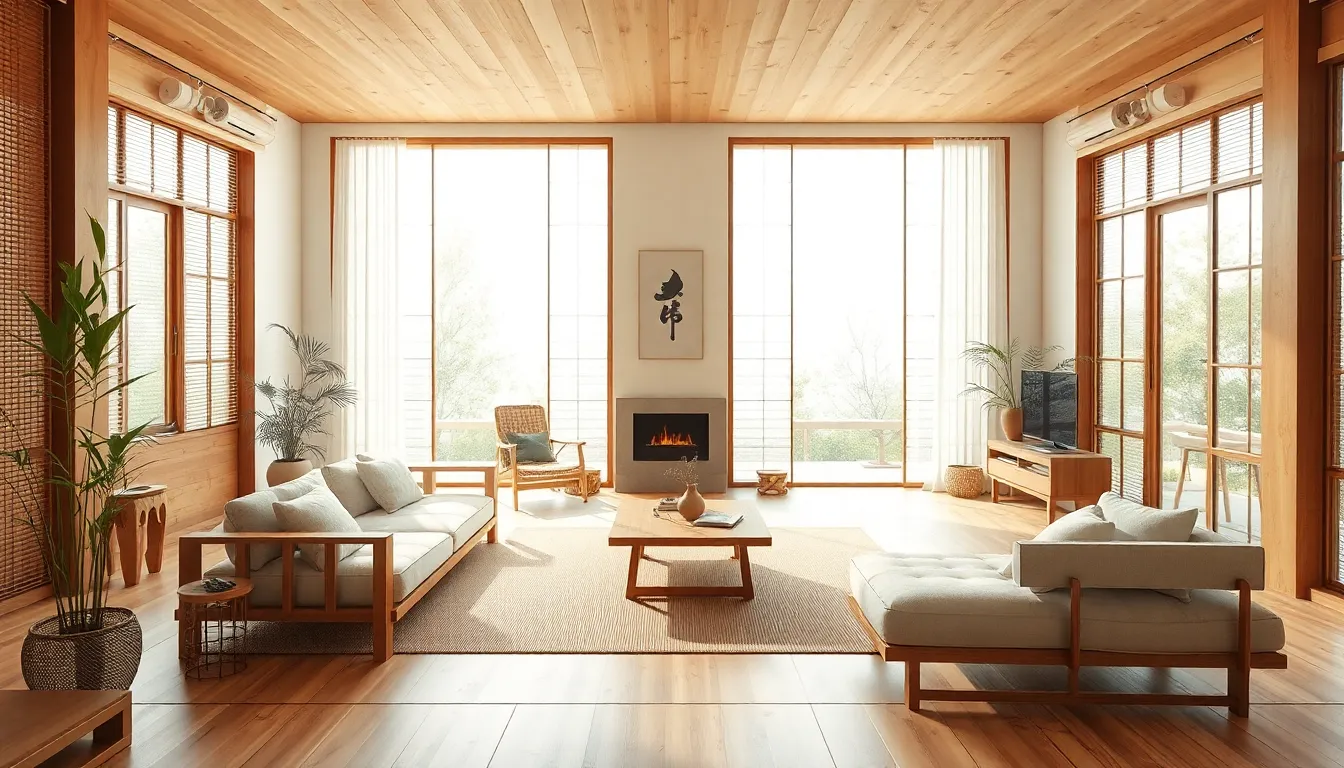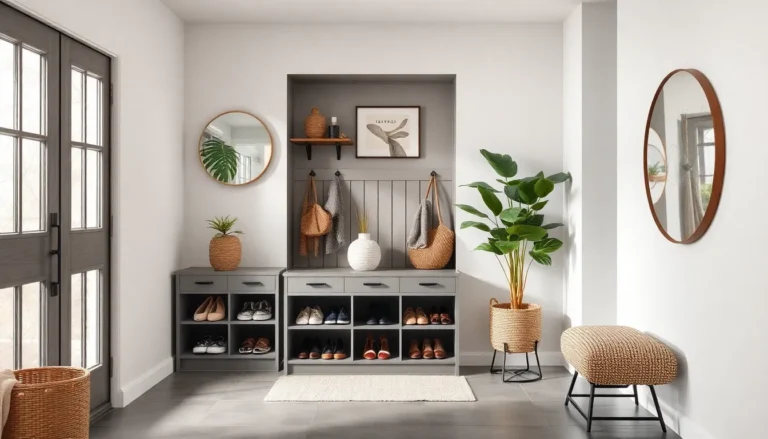Imagine stepping into a space where tranquility reigns, and chaos takes a backseat. Zen home design isn’t just about aesthetics; it’s a lifestyle choice that transforms everyday living into a serene experience. By blending simplicity with nature, it invites calmness into homes that often feel like a circus on roller skates.
In a world that’s constantly buzzing, creating a Zen sanctuary can feel like finding a needle in a haystack. But fear not! With the right elements, anyone can craft a peaceful retreat right in their living room. From minimalist furniture to soothing color palettes, Zen design is all about embracing the art of less. So grab a cup of herbal tea, kick back, and discover how to turn your home into a blissful haven that even your most anxious friends will envy.
Table of Contents
ToggleOverview of Zen Home Design
Zen home design embodies a lifestyle that cultivates tranquility and harmony. This design approach merges simplicity with natural elements, aiming for a peaceful environment in daily living.
Principles of Zen Aesthetics
Balance forms the core of Zen aesthetics. Spaces are often open and airy, fostering a sense of calm. Natural materials like wood, stone, and bamboo emphasize a connection to nature. Soft, neutral colors create a soothing atmosphere. The focus remains on fewer but meaningful decorative items, which enhance visual clarity. Light plays a crucial role, with ample natural light promoting serenity. Each element within the space should inspire a feeling of relaxation.
Importance of Minimalism
Minimalism simplifies life by reducing clutter. This approach encourages individuals to prioritize only essential items, making their environments more peaceful. When homes utilize fewer possessions, they often foster a clearer mind. Limited color palettes contribute to this simplicity, often consisting of whites, beiges, and muted tones. Functional furniture enhances both practicality and aesthetics, aligning with Zen principles. The outcome is a stress-free space that supports mindfulness and well-being. Minimalist design does not compromise style; instead, it enhances tranquility and balance.
Key Elements of Zen Home Design

Zen home design thrives on harmony and simplicity. Key elements contribute significantly to creating a serene living space.
Natural Materials
Natural materials form the backbone of Zen aesthetics. Wood, stone, and bamboo enhance connection to nature. These materials foster warmth and invite tranquility into living spaces. Eco-friendly choices align with sustainability principles, promoting healthy indoor environments. Using unrefined finishes, such as untreated wood or natural stone, allows for authenticity. Natural textures add depth and interest, maintaining visual simplicity. Intentional selections encourage a calming atmosphere, essential for stress-free living.
Open Spaces
Open spaces play a crucial role in Zen home design. Spacious areas allow for flow and movement, reducing feelings of congestion. The layout should promote easy navigation, creating a harmonious living environment. Eliminating unnecessary walls and obstacles enhances a sense of freedom. Minimalist furniture complements open spaces, offering function without overwhelming design. A well-thought-out arrangement encourages mindfulness and relaxation. Enhancing natural light through large windows contributes to an airy feel, further emphasizing space.
Color Palettes in Zen Home Design
Choosing the right color palette is crucial for achieving a serene atmosphere in Zen home design. Calm hues enhance the overall tranquility and balance.
Neutral Tones
Neutral tones play a significant role in creating a peaceful environment. Soft whites, beige, and gentle greys evoke simplicity and clarity. These colors foster mindfulness, allowing the mind to relax and disengage from daily stress. Using these shades throughout the space promotes harmony. Accent pieces in neutral tones provide visual continuity, contributing to a spacious feeling.
Incorporating Earthy Colors
Earthy colors connect interiors with nature, reinforcing the Zen philosophy. Shades of brown, green, and muted terracotta create a grounded atmosphere. These colors evoke the natural world, inspiring a sense of stability. Incorporating these hues into furniture, textiles, and decor enhances warmth. Earthy tones also encourage relaxation, making space feel inviting and tranquil. Using them mindfully balances minimalist aesthetics with a natural touch, enriching the overall design.
Zen Home Design Inspirations
Zen home design offers a variety of inspirations that reflect tranquility and serenity. Different styles blend traditional elements with modern aesthetics to create a peaceful environment.
Traditional Japanese Influence
Traditional Japanese design significantly influences Zen aesthetics. The use of tatami mats creates a natural flooring option that promotes simplicity. Sliding shoji screens offer flexibility in room configurations while allowing soft light to filter through. Minimalist furnishings feature low profiles, emphasizing openness and allowing easy movement. Incorporating natural materials like bamboo and wood connects interiors with nature, fostering a serene atmosphere. Elements such as enclosed gardens, known as karesansui, bring the calming presence of nature indoors, enhancing mindfulness and relaxation.
Contemporary Adaptations
Contemporary adaptations fuse Zen principles with modern designs. Open floor plans facilitate a sense of flow and spaciousness that calms the mind. Incorporating sustainable materials, like reclaimed wood and recycled metals, aligns with eco-friendly values while enhancing aesthetic beauty. Furniture with clean lines complements minimalist spaces, prioritizing functionality without sacrificing style. Bright, airy spaces utilize large windows that invite natural light and greenery, reinforcing a connection to nature. Color palettes featuring soft neutrals and earth tones maintain tranquility, ensuring that contemporary Zen homes remain inviting and peaceful.
Benefits of Zen Home Design
Zen home design offers numerous advantages that enhance everyday living. Its principles promote tranquility and mindfulness, making spaces more inviting and peaceful.
Enhancing Mindfulness
Mindfulness thrives in environments designed with Zen principles. Open spaces encourage reflection and focus, allowing for deeper connections with oneself. Natural materials promote a sense of grounding and present awareness. Adding elements like indoor plants enhances the sensory experience and supports mental clarity. Sot, neutral colors further aid in maintaining a calm atmosphere, reducing distractions. Practicing mindfulness becomes intuitive in such serene surroundings. Connecting with nature through design invites relaxation, fostering an overall sense of well-being.
Creating a Serene Environment
Serenity forms the foundation of Zen home design. Large windows effortlessly connect interiors to outdoor landscapes, flooding spaces with natural light. Minimalist furnishings create an uncluttered aesthetic, allowing room for peaceful interactions. Soft colors evoke a calming vibe, nurturing relaxation. Incorporating elements like water features can enhance tranquility and soothing sounds. Natural materials such as wood and stone promote warmth, enriching the atmosphere. Inviting deliberate simplicity into design choices leads to easier navigation and fosters a truly serene setting. These aspects work together to cultivate a restful retreat within the home.
Zen home design offers a pathway to tranquility in an often chaotic world. By embracing simplicity and natural elements, anyone can create a serene retreat that promotes mindfulness and well-being. The thoughtful integration of open spaces, neutral color palettes, and sustainable materials enhances not just the aesthetic appeal but also the overall quality of life.
Incorporating these principles allows individuals to cultivate a peaceful environment that fosters clarity and relaxation. Whether through traditional Japanese influences or contemporary adaptations, the essence of Zen design lies in its ability to harmonize living spaces with nature. Ultimately, a Zen-inspired home serves as a sanctuary that nurtures the mind and spirit, inviting calmness into everyday life.



